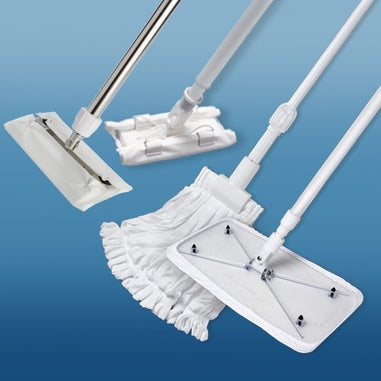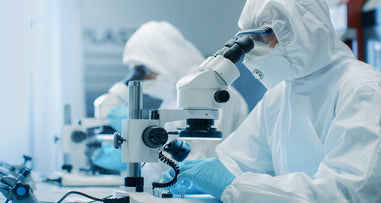- No products in the cart.
A well-designed cleanroom should be easy and low-cost to maintain. In the pharmaceutical industry, maintaining compliance is important on many levels: your facility, your staff, your product, and your patients. Here are eight, requirements that will help you keep your cleanroom facility compliant and efficient.
#1. Smooth surfaces
A smooth surface (even the ceilings!) means no rivets, no bolts, and as minimal tubing/connections as possible. Seams should be minimized and sealed smoothly with an appropriate sealant when unavoidable. All surfaces should be kept free of debris other than the tools immediately needed.
#2. Pressure requirements and doors
A cleanroom typically operates at a higher pressure than the rest of the building it is connected to. This is to keep airflow going out, rather than in (and thus avoiding the entrance of outside particulates. The door should always swing into the higher-pressure room. While some labs opt to pay extra for completely sealed doorways for this reason, it isn’t necessary – and may actually be costing you more. A small amount of airflow out of your cleanroom doesn’t pose a bioburden threat and can help to decrease cross-contamination during opening and closing the door by keeping the pressure more static. In fact, a small amount of airflow can also relieve some of the force on the door itself, as well as the entire facility, keeping it functional for longer.
#3. Product and personnel flow design
It’s always a good idea to assess the flow of products and personnel within the cleanroom. A poor understanding of this flow means more staff, time, cost, and ultimately a loss in production. A well-designed cleanroom will take this flow into consideration when deciding where to place equipment and supplies.

#4. Regular cleaning and maintenance (SOPs)
Your standard operating procedures should be detailed and readily available. Good SOPs should minimize contamination risk, monitor air quality, and promote good practices from staff.
#5. Cleaning and maintenance documentation
Regular maintenance and cleaning is crucial to making sure your cleanroom is being operated correctly to maintain air quality. Good documentation can also help identify problems before they arise, allowing you time to solve them before it affects production.
#6. The right supplies for your cleanroom
Depending on your USP requirements (sterile or non-sterile), you should design your cleanroom maintenance procedures appropriately. Some cleanrooms require specialized equipment such as a Laminar flow hood or hands-free sinks. Likewise, the cleaning supplies used should be chosen with their properties in mind. Surfaces should be regularly cleaned to reduce contamination risk. Isopropyl alcohol, hydrogen peroxide, and bleach are all commonly used sanitizing agents. Detergent-based surface cleaning solutions can also be used. Research has also shown that rotating cleaning agents can be useful to prevent the development of resistant microbes.
When choosing a cleaning agent, know your cleanroom requirements for pharmaceuticals (797 sterile/795 non-sterile) and how your surface will react to them. Never use a cleaning agent that can degrade your surfaces and cause the development of cracks and crevices that can act as a dangerous microbial breeding ground.
#7. Appropriate handling of hazardous chemicals
Always keep safety in mind when dealing with hazardous chemicals or drugs such as chemotherapy agents. If you compound such drugs, you must maintain USP 800 compliance. Use of a biosafety cabinet will ensure that hazardous compounds are out of the airflow. Likewise, always dispose of such drugs responsibly as to not introduce your staff to hazards.
#8. A comfortable staff
Working in a clean room can sometimes feel like being cooped up in a bleak prison cell, but there are some things that you can do to ease that feeling. The addition of a window helps staff feel more comfortable and has been shown to increase staff retention in cleanroom positions. A seamlessly installed window to an exterior space will make the room feel less cramped.
Likewise, good lighting is important – but don’t overdo it. A dimly lit cleanroom not only creates an unwelcoming workspace, it also creates problems in finding unclean surfaces or areas, particularly in corners. Conversely, don’t overdo the lighting either. Although an unpleasantly bright room will help you to see every crevice, it can also irritate staff and take up valuable ceiling real estate that could otherwise be optimized for HVAC design. Comfortable staff helps keep an efficient cleanroom functioning at a high level.
In the end, all of these topics affect the functionality of your facility, while following the cleanroom requirements for pharmaceuticals. To keep your facility compliant with established USP standards, all of these come down to two key factors: supplies and design. Design your facility well and buy supplies from a retailer you can trust.
__
For over 40 years, Lab Pro has been committed to delivering a complete pharmaceutical laboratory solution by offering the highest quality cleanroom products, chemicals, reagents, microscopes and imaging equipment for our customers worldwide. Come visit the biggest Lab Supply showroom in the Bay Area, or contact us online or at 888-452-2776.












































